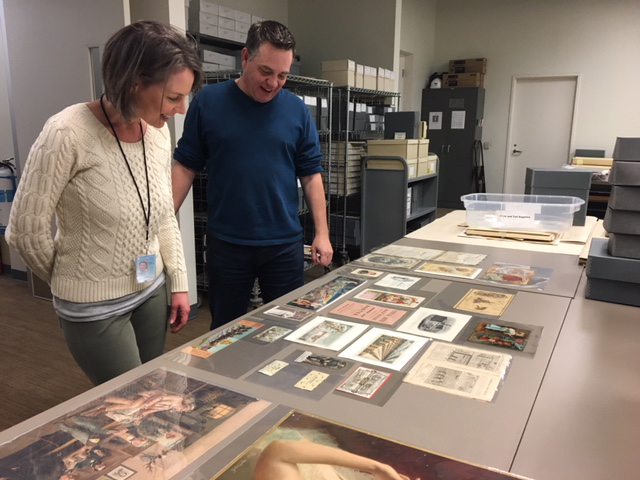Tapping into beer culture
Historian Theresa McCulla interprets American culture through the history of our long love affair with beer and brewing.

From the American History Museum’s collection of beer- and brewing-related ephemera. (Photo by Amy Rogers Nazarov)
The idea of a bunch of middle-schoolers guzzling beer in the backyard is more likely to alarm modern parents into staging an intervention than it is to inspire a knowing chuckle. That’s one reason why a cheeky 19th-century trade card for Yuengling beer featuring several tween-age boys sneaking a few bottles while an angry nursemaid shakes her fist just out of reach makes such a strong impression.
The picture on the card provides clues about American labor, economics, advertising, science and leisure time before the turn of the 20th century, all through the lens of the country’s then-nascent brewing industry, says Theresa McCulla, brewing historian at the National Museum of American History. As part of the museum’s American Brewing History Initiative, she is charged with collecting stories and objects related to the history of beer making in the U.S.
When you consider the lack of standardized laws related to drinking age in the 1800s (the National Minimum Drinking Age Act did not become law until 1984), or that companies positioned beer’s “purity” as a selling point, or that kids actually provided labor in the industry (their employment was a strategy to pay lower wages), you understand just a few of the cultural shifts that have taken place in the last century or so.

From the American History Museum’s collection of beer- and brewing-related ephemera. (Photo by Amy Rogers Nazarov)
Although Native Americans had long brewed beverages fermented from corn and other plants, immigrants from England and Germany brought new brewing techniques from the Old World to the New World, McCulla says. For many, brewing was simply another homely chore like canning or putting up preserves. However, new technologies allowing for mass marketing and other aspects of print culture helped drive demand for trade cards, calendars, posters and other appealing giveaways that helped companies market and sell more beer. “Also, especially in the decades after the Civil War, which were a long period of industrialization, people were fascinated by anything high-tech,” such as factory-sized breweries with innovative refrigeration techniques, McCulla adds. Beer became big business.
Food and drink–and their place in American society and culture–permeate McCulla’s professional and personal history. She completed her doctorate in American Studies at Harvard University in 2017, studying foodways of New Orleans during the 19th and 20th centuries for her dissertation. Her father was a home brewer; as a child, McCulla and her siblings snapped caps onto bottles and did other odd jobs to help. She also holds a cooking degree from the Cambridge School of Culinary Arts in Massachusetts; has managed farmers’ markets; and has worked for free in elite kitchens such as that at Ray’s the Steaks in Washington to round out her expertise around America’s food landscape from multiple vantage points.

From the American History Museum’s collection of beer- and brewing-related ephemera. (Photo by Amy Rogers Nazarov)
As part of her work at the museum, McCulla travels across the U.S. gathering both stories and objects from small- or home-based brewers with an eye toward building a more comprehensive collection of brewing equipment and ephemera that will tell the story of the United States. “We have a lot of opportunity to expand the collections,” she explains. “We’re interested in objects that have been used and touched.”
No one who enjoys kicking back with a cold one needs to be told that the craft brewing industry is exploding in the United States. Craft brewers brew in small batches, developing idiosyncratic twists on traditional ingredients and techniques to develop distinctive styles and tastes. According to the Brewers Association for Small and Independent Brewers, most Americans live within 10 miles of a craft brewer.

From the American History Museum’s collection of beer- and brewing-related ephemera. (Photo by Amy Rogers Nazarov)
McCulla dates the start of the craft beer revolution to the 1960s, when San Francisco’s Anchor Brewing staved off bankruptcy by reviving its recipe for “steam” beer and shifting to production of little-known English beverage styles, all under the new leadership of Fritz Maytag III. “I like to [examine] a slice of a city or region” to see what its brewing history tells us about numerous trends in American history, she says, citing the Pacific Northwest, Milwaukee and the greater metro D.C. area as other key markets around which a brewing culture and economy arose. (For example, Dupont Circle’s Heurich House Mansion was once the home of one local preeminent and wildly successful brewer, German immigrant Christian Heurich).
In the history of beer, as with the history of America’s labor force and economy, some “complex and messy and very problematic” threads are woven, McCulla adds.

Historian Theresa McCulla and Joe Hursey, Archives Center Reference Coordinator, look over beer- and brewing-related ephemera in American History’s Archives Center. (Photo by Amy Rogers Nazarov)
Posted: 16 February 2018
- Categories:



